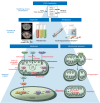Mitochondrial metabolism in pulmonary hypertension: beyond mountains there are mountains
- PMID: 30080181
- PMCID: PMC6118596
- DOI: 10.1172/JCI120847
Mitochondrial metabolism in pulmonary hypertension: beyond mountains there are mountains
Abstract
Pulmonary hypertension (PH) is a heterogeneous and fatal disease of the lung vasculature, where metabolic and mitochondrial dysfunction may drive pathogenesis. Similar to the Warburg effect in cancer, a shift from mitochondrial oxidation to glycolysis occurs in diseased pulmonary vessels and the right ventricle. However, appreciation of metabolic events in PH beyond the Warburg effect is only just emerging. This Review discusses molecular, translational, and clinical concepts centered on the mitochondria and highlights promising, controversial, and challenging areas of investigation. If we can move beyond the "mountains" of obstacles in this field and elucidate these fundamental tenets of pulmonary vascular metabolism, such work has the potential to usher in much-needed diagnostic and therapeutic approaches for the mitochondrial and metabolic management of PH.
Conflict of interest statement
Figures


References
-
- Simonneau G, et al. Updated clinical classification of pulmonary hypertension. J Am Coll Cardiol. 2013;62(25 suppl):D34–D41. - PubMed
Publication types
MeSH terms
Substances
Grants and funding
LinkOut - more resources
Full Text Sources
Other Literature Sources
Medical

